「BOOTH Cafe」アップデート特別インタビュー!このチームだからこそできた「出会い」の体験とは?
インタビュー/タカオミ

2023年8月に公開された、アバターを自由に試着できるワールド「BOOTH Cafe」。アバターの3Dモデルを展示するのではなく、その場で着替えられるアバターぺデスタルが利用できることや、選択したアバターと似た雰囲気のアバターを検索することができるシステムなど、これまでの「アバターワールド」とは一線を画した体験が話題となりました。12月1日には、ワールドに登録されているアバターが300体から700体以上に増加するなど、大型のアップデートが実施されました。今回はそんな「BOOTH Cafe」の制作チームにインタビューし、「BOOTH Cafe」の制作秘話や、チームでつくることの魅力をお伺いしました。
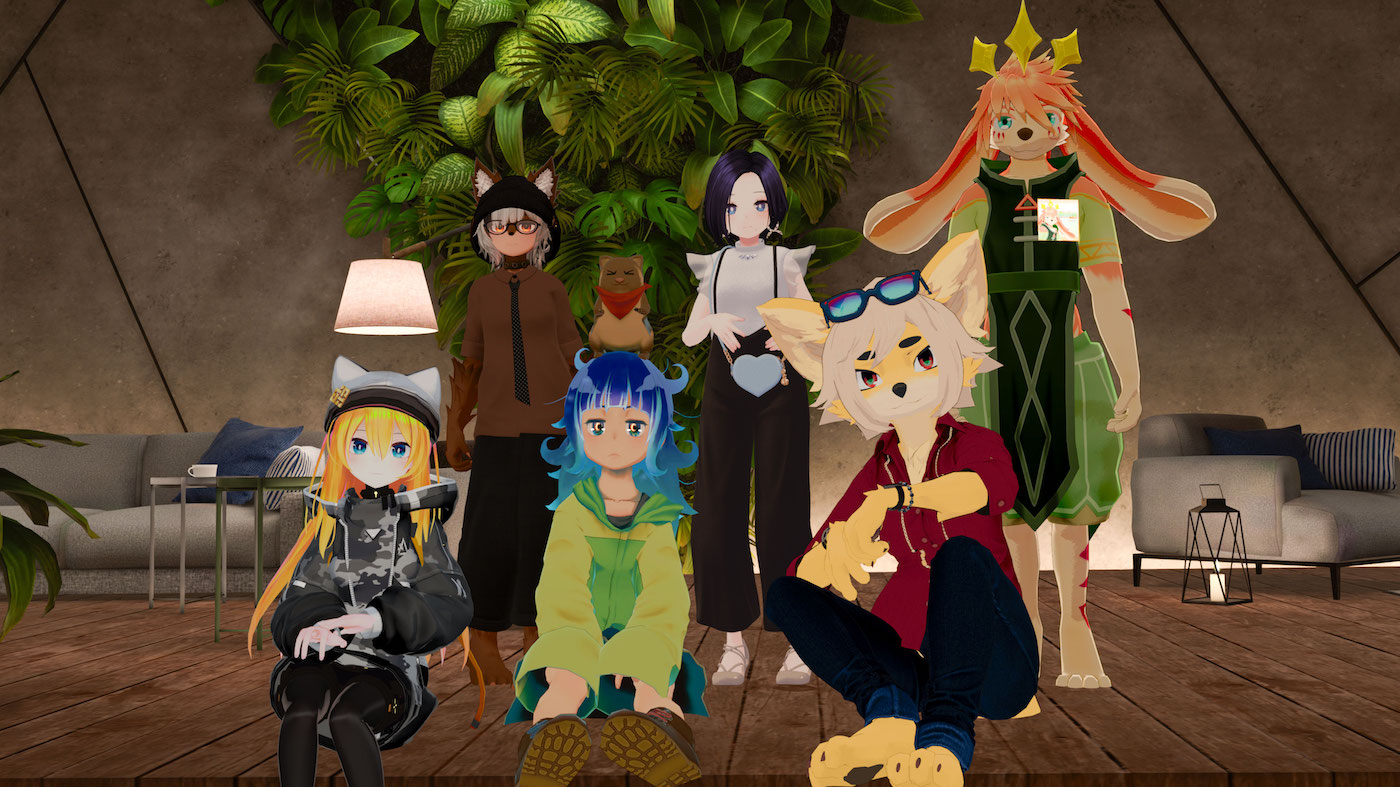
(画面上部左から、るらさん、Wakaさん、momomaさん、下部左から、超蔟さん、浦上さん、Kenomoさん)
浦上:3DCGArtist
超蔟:3D Modeler / Technical Planner
Waka:3D Modeler
momoma:Technical Artist
るら:3DCGArtist
Kenomo:Planner / Sound Designer
「BOOTH Cafe」ができるまで
── まず初めに、皆さんの担当箇所をご説明していただけますか?
浦上: 自分はディレクターを担当しました。BOOTHさんから頂いたご要望をもとに、VRChatでどう実現するかという企画の部分と、作る上で「こうしてほしい」というディレクションをしたり、細かい小物を作ったりとかもやっています。
超蔟:自分は主に登録されているアバターのタグの振り分けや、どういうタグを選定するかといった、実際に登録されるデータベースの大本を作るところを主に担当してました。
momoma:自分は中央にあるアバターペデスタル周りのギミックの実装部分を主にやっています。体験デザインも含めてみなさんと検討し、プロトタイプを組んで試行錯誤しながら実装しました。たくさんのアバターのデータを扱うことになるので、多くのデータを軽量に処理できるアルゴリズムを工夫したりしています。
Kenomo:自分は肩書はサウンドデザイナーで、BOOTH Cafeのワールド全体のサウンドをどういう感じにするかというところの企画と、あとはBGMとかSEの音源の作成と、ギミックに深く関わらない部分のUnityの実装作業っていうところまで、サウンド関連を担当しました。
Waka:わたしは建物部分の設計とモデリングですね。カフェ空間とアバターペデスタルを置く空間があるんですけど、いろんな空間があったほうが写真が撮れて楽しいよね、っていうアイデアを頂いたので、みんなでつくっていきました。全体のデザインは私の好み全開のものになってます。

── それではワールドについてお話を伺いたいのですが、まずは「BOOTH Cafe」のコンセプトをお話いただけますか?
浦上: ピクシブさんからBOOTHの商品を紹介するワールドを作りたいという相談を頂いて、第一弾としてBOOTH Houseの企画を出しました。そして第二弾ではアバターを出したい、というお話をいただいて。
BOOTHで配布されているいろんなアバターが欲しい人に届いていないこともあると思うので、「アバターとの出会い」から考えました。
とはいえ、アバターの着替えだけを置いてても、着替えるためだけにワールドに来てもらうというのはなかなか難しい。カフェ空間もつくることで、誰かとそこで気軽にお話したり、ワールドの景色を楽しみながら一緒にアバターを着替えてもらったり、といった体験をしてもらえたらいいなと。
当初のアバター、そして人、二重の意味での「出会い」をコンセプトに考えています。

CDをジャケットで選ぶように、アバターを選ぶ体験
── 「BOOTH Cafe」のシステムで特にユニークなのは、雰囲気の近いアバターが出てくるギミックだと思いますが、これはどこから出てきたアイデアだったんですか?
momoma:最初はこの形じゃなくて、BOOTHの検索みたいにタグそのものを使って検索するという案とかがいろいろあったんですけど、「VRChatの中でやらなくてよくない? BOOTHのウェブページでいいじゃん」って話になっちゃって。
じゃあVRChatの中でアバターとのいい出会いを生むにはどうしたらいいのかと考えたときに、いまのアイデアが出てきました。ECサイトだと「この商品を買った人はこちらの商品も~」みたいなのが出てきますよね。それに近い考え方です。
並んでいるアバターペデスタルの中から一個選ぶと、どんどん似たようなアバターが出てくるシステムならシンプルでわかりやすいし、同様のサービスでは見たことないのでおもしろいものになるのかなあって感じで進んでいきました。
※アバターペデスタルとは、VRChat内でタッチすることでアバターを変更できる正方形の板のこと

浦上: 最初はたとえば目の大きさとか、髪色だったりとか、そういうのをパラメータ調整したら近いアバターが出てくるみたいな機能を想定してたんですね。でも操作回数が多くなってしまって、気軽に触れるものではなくなっちゃうので、超蔟さんとmomomaさんといろんなワールドをめぐりながら、アイデアを出しつつ、いまのところに落ち着いてきたという流れでした。
超蔟: 登録されているタグも、最初の頃は髪色とか具体的な要素で考えていたんですけど、VRChatの世界にいるアバターをそうやって区分けしていこうとすると、どんどん言葉が増えていってしまう。システム的にはどうしても登録できる情報に上限があるので、最終的には「まるっこい」だとか「細長い」みたいな、ふわっとした雰囲気を表すタグになりましたね。
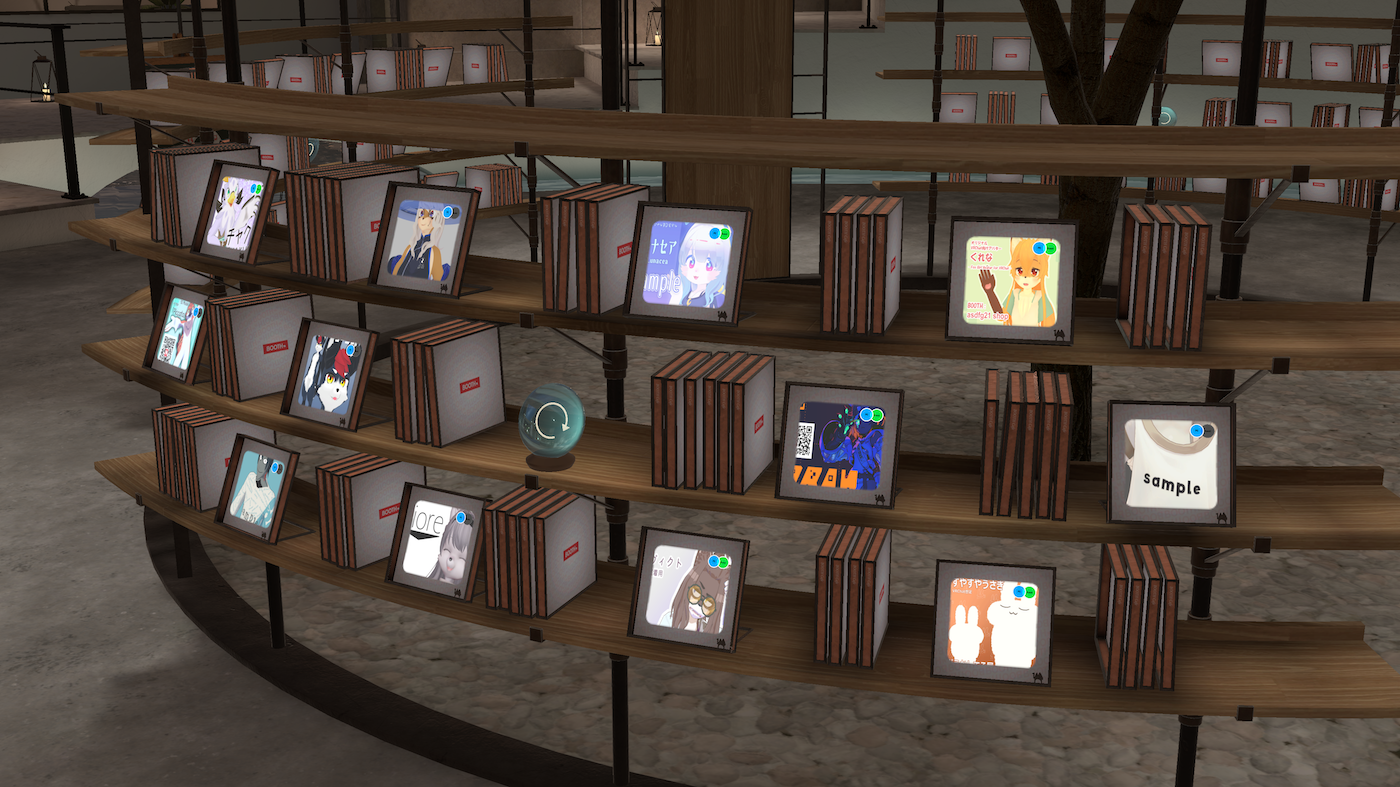
── ペデスタルをたくさん並べてアバターを検索するアイデアはどこからきたのでしょうか?
超蔟: ペデスタルが純粋にいっぱい並んでいるワールドに行ったら、思った以上にそれが楽しかった。CDのジャケットを見て選ぶみたいで楽しいから、これ、いいんじゃない? ってところから今の形になってますね。
浦上: そこから更に拡張してって、カフェみたいな空間にしよう、ってアイデアが出てきて、どんどん膨らんでいった感じですね。最初は検索ギミックだけが置いてある、ちょっとデジタルなワールドを作ろうかなという感じになってたんですけど。

アバターペデスタルとカフェが融合した空間設計
── アバターぺデスタルが円柱状に並んでいますが、これはWakaさんのアイデアでしょうか?

Wakaさんによる設計時のスケッチ。当初は2階建てのプランもあったようだ。
── 最終的に今の形になった決め手はどういったものでしょうか?
Waka:最初はカフェとアバターペデスタル群を離れたところに置いてたんですよね。でも、離してしまうと、カフェとアバターペデスタルのどっちを先に見せるかという話になってしまって。その辺がすごく難しくって、もっと近づけたほうがいいよねということで、今の形になりました。

── 「BOOTH House」ではBOOTHで販売されているアセットをたくさん使っていましたが、今回の「BOOTH Cafe」は全部オリジナルモデルなのでしょうか?
るら: いえ、結構アセットも使っています。既存の使いやすいアセットを使いつつも、オリジナルのモデルを作ってオリジナル感を出していこうという感じでしたね。
── 既存のアセットを使いつつ、オリジナル感を出すコツはありますか?
るら: うーん、難しいですね(笑)
既存のアセットよりも目をひくユニークなアセットをつくってポイントにするでしょうか。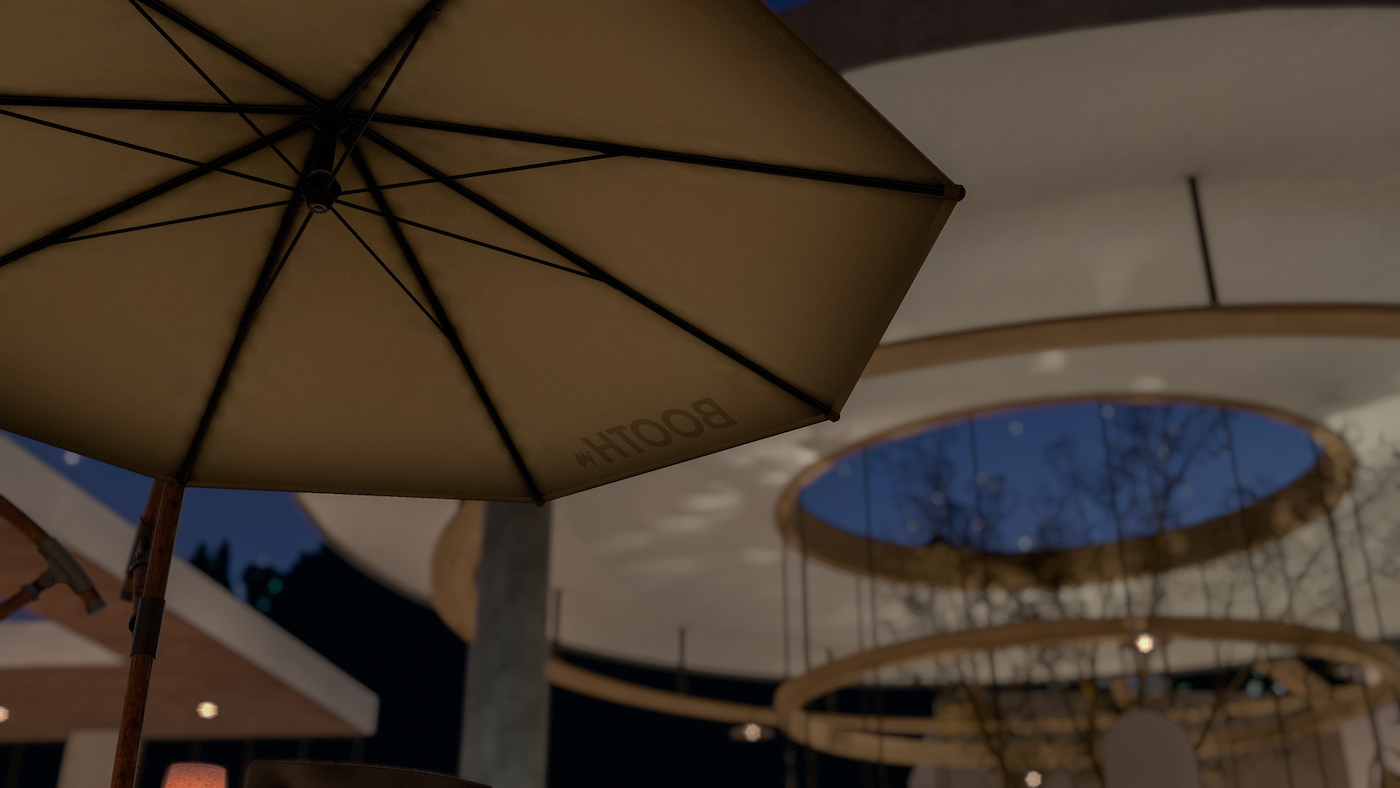
動的に変化するワールドBGM
── 「BOOTH Cafe」といえば、エリアごとに動的に変化していくBGMも特徴ですよね。
Kenomo:VRChatのワールドでBGMがインタラクティブに変化していく、いわゆる「インタラクティブミュージック」みたいな試みは少ないのですが、ゲームではエリアが変わったら音数が増えたり減ったりするのが当たり前になってきています。自分もそういった実装をしてみたくて、BOOTH Cafeでチャレンジさせてもらいました。
── サウンドに関して、浦上さんやモデラーのWakaさんからはどういったフィードバックがあったのでしょうか?
浦上:最初から素敵なものができてたので、ここはもうちょっと静かにしたい、とかぐらいですかね。基本的にはほぼ何も言ってない気がします。
Waka:アバターのペデスタル周りはコミュニケーションを邪魔にしないようなものがいいねって、超蔟さんも交えて3人でお話した覚えがあります。
Kenomo:キッチンのところは、みんなが一番集まってガヤガヤするところなので、ちょっと音的には多めで……みたいな感じで。そこから離れていくと、まったりした感じになっていく設計になっています。
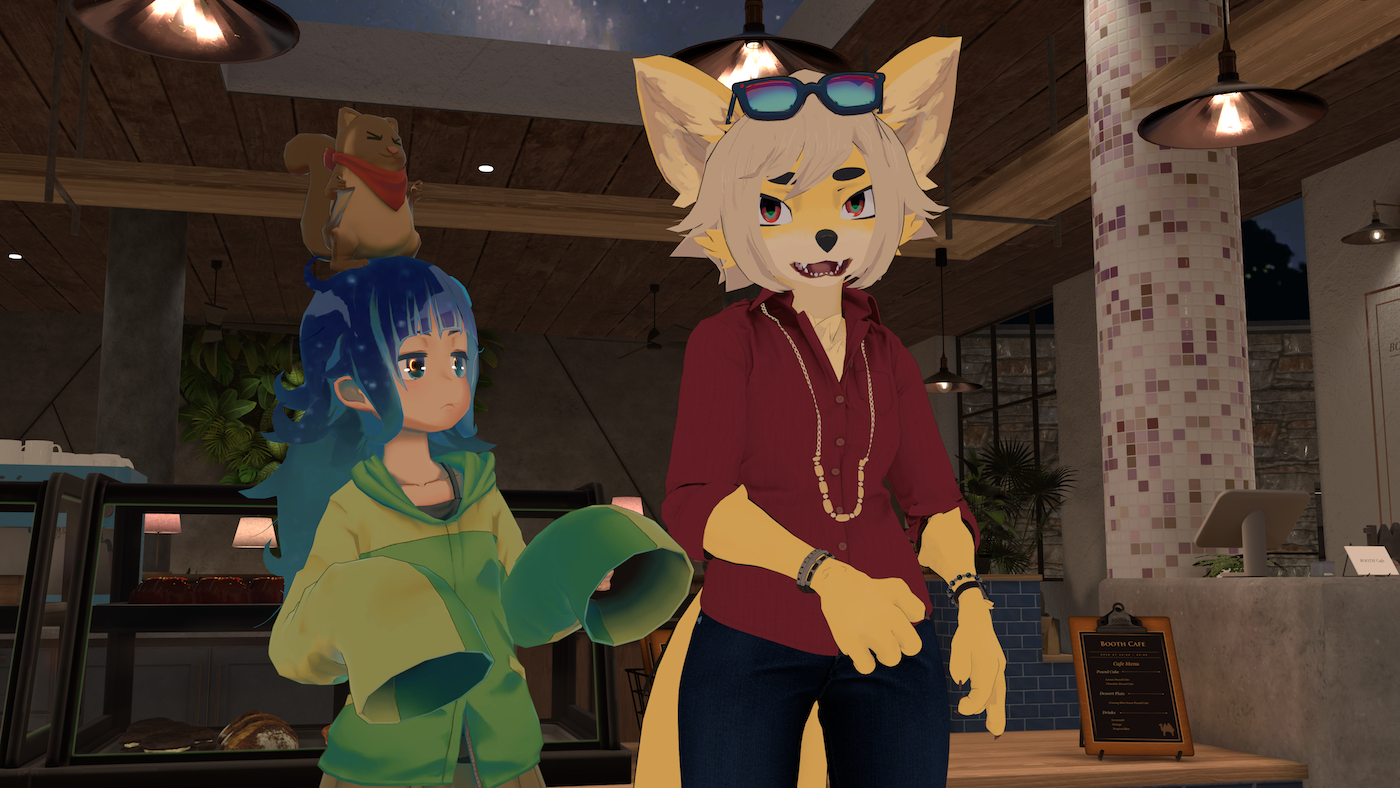
目指すは登録アバター2,000体
── 今後公開が予定されている、誰でもアバターを登録できる仕組みですが、これはどなたからのアイデアなんですか?
浦上: 企画当初からBOOTHに登録されているアバターを全部出したいと考えていました。容量等の関係で難しいということになっていたのですが、ペデスタルの方式になったことで、これならできるんじゃないかなと。ただ第一弾で一気にやっちゃうのは大変なので、最初は募集のみにして、問題なさそうであれば徐々に広げていくという方針になりました。
── momomaさんもギミックを作る段階で全てのアバターが登録できるようになることを想定されていたのでしょうか?
momoma:そうですね。最終的にアバターがどれくらいの数になるかという話は最初にしてたと思います。その時点で、「4桁いけるといいよね」ということだったので、これはかなり検索システムを高速化しないといけないなあ、という気持ちでやりました。

── ちなみに今回の募集はどれくらいの応募がきたんですか?
浦上: 前回が300で、今回でプラス400くらい増えました。
── そろそろ1,000体になりますね。
浦上: まだまだ応募してもらいたいです。テストで試して2,000くらいだったら普通に動いてたので、できれば2,000はいきたいですね。
── アバタークリエイターさんからの反響はどうでしたか?
浦上: 第1弾のときに登録してくれたアバタークリエイターさんで、Cafe登録後に結構売れたと話されている方はいました。
── しっかり効果があったわけですね。
浦上: そうですね。欲しい人にちゃんと届くワールドにしたいと思っていたので、達成されてよかったです。アバタークリエイターさんにも、アバターを使うユーザーさんにもメリットのあるワールドができたんじゃないかなと思います。
── ユーザーさんから頂いた反応はどんなものがありましたか?
浦上: ワールドがとてもきれいだという声をいただいてますね。
X(旧Twitter)でも、「BOOTH Cafeで気になる子をみつけて、ようやく買えた」みたいな話をされてる方もいたので、ちゃんと欲しい人にアバターが届いていると実感しています。

アップデートでさらにわかりやすくなった体験面
── 12月1日に実施されたアップデートについてご説明いただけますか?
浦上:ユーザーさんからの声を踏まえてチームのみんなと話していて、中心のペデスタルのギミックに気づかれないことがあるとわかりました。なので、できるだけギミックだとわかるようにデザインを変えています。
それと、お気に入り検索機能は、雰囲気の近いアバターが出てくる機能なんですが、シャッフル機能だと勘違いされてたりとか……。そこも、体験面でもう少しわかりやすく伝わるようデザインを変更しています。
あとは検索のギミックのアルゴリズムがちょっと変わったので、精度が高くなってます。
momoma:タグの種類や組み合わせによって、マイナーなタグが多いアバターは出にくくなってしまうことがありましたが、数値とかアルゴリズムを調整して、いいバランスで出るよう再調整しました。
── ワールドのモデルのアップデートはありますか?
浦上: ただのペデスタルに見えないようWakaさんにペデスタルを囲うフレームをつけてもらったり、ちょっとカフェ感のあるボードを用意してもらったりしてます。
Waka:以前はペデスタルそのままの見た目で置かれていたのですが、雰囲気を出すようなフレームをつけています。ギミックの使い方を記載したボードも配置して、よりわかりやすくなりました。

ペデスタルの新旧比較。画像左が以前のもの、画像右が新しいもの。
浦上: あと、みなさんからの要望である大きなミラーをつけたので、レイアウトを調整していただいてます。
── やっぱりユーザーの皆さんはミラーがほしいんですね。
浦上: そうですね(笑)
あえてなしにしていたんですけど、やっぱりミラーの力には勝てなかった…。
(一同笑)
浦上: ギミックも検索しやすくなり、アバターもめちゃくちゃ増えて楽しくなってますので、そちらもぜひ触ってみてください。
── ユーザーの滞在時間がますます増えそうなアップデートですね。
創作を続けられている理由と、VRChatの魅力
── 皆さんがVRChatで創作活動を続ける理由はなんでしょうか。
浦上: クリエイティブな活動が楽しいのもありますが、純粋にVRChatっていう空間がとても心地よく、フレンドさんがいて楽しいってのが強いです。
それと、VRChatを利用するみなさんの思い出作りに貢献できたらなあっていう思いもあります。
超蔟:やっぱり自分で作ったものを自分で見たいから続けられていますね。自分が作ったものを、自分でも見られるし、それをフレンドのところに持っていけば、他の人にもそのまま見せることができる。見せることのコストの低さに惹かれてずっとやっているところはあると思います。
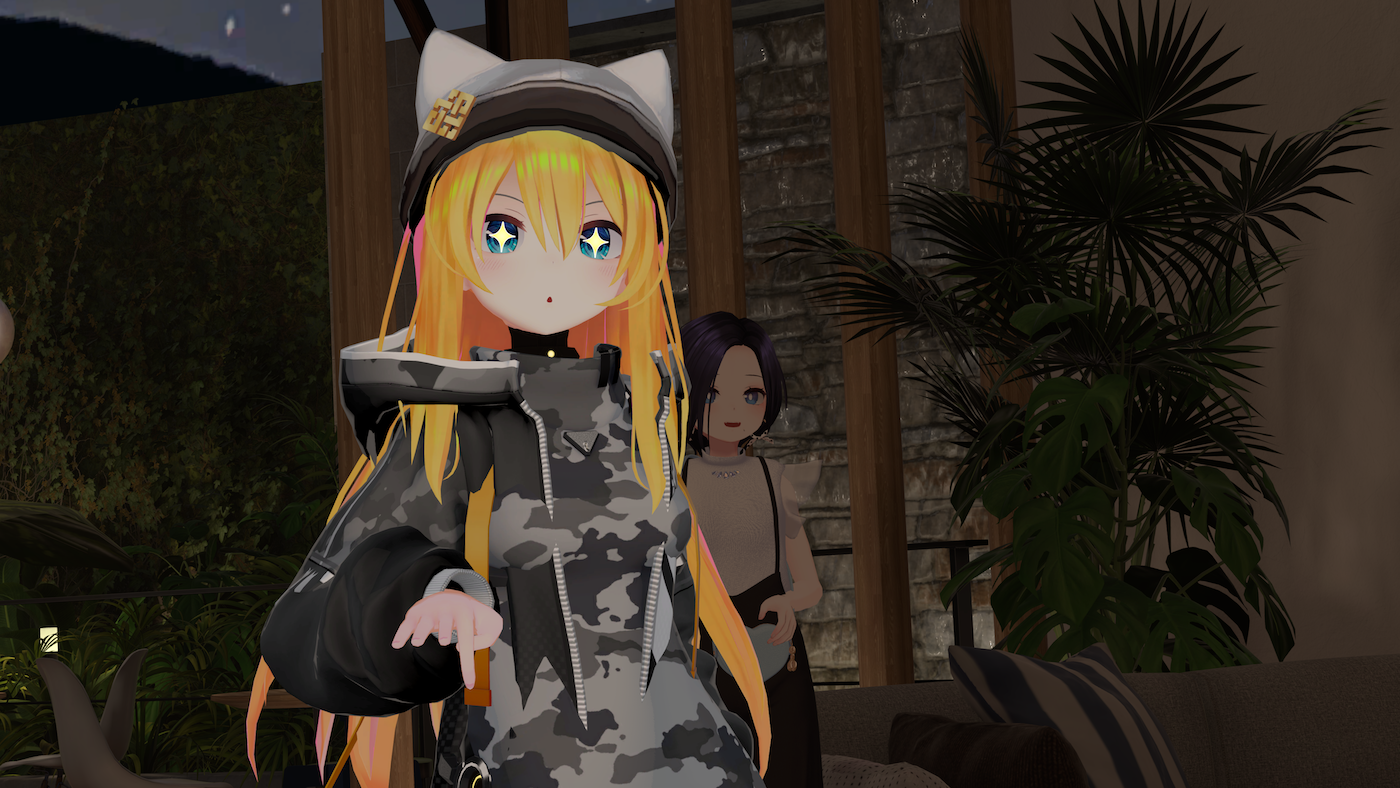
momoma:自分もわりと超蔟さんに近いかな。
それに、VRChatにある知覚は見る、聞くだけなのですが、体験できるっていうところが、すごくいいなと思っていて。フレンドと会って他愛のない会話をするのも体験だし、「BOOTH Cafe」にお出かけするのも体験だと思います。いろんな体験を味わえて、自分でつくることもできるところが魅力的だと感じています。
Waka:わたしも超蔟さんとかと似てて、クリエイターとして家作りが好きなので、形あるものがすぐ見れるっていうのがいちばんですかね。あと、勉強する分野が多いのも、しんどいんですけど楽しい部分かなと思ってます。シェーダーであったりとか、モデリングソフトだったりとか、詳しい人に直接VRChatの中で教われるじゃないですか。普通に生活してたら会えない人ばっかりなので、そういうふうに教わりながら、勉強するのが楽しいと思ってます。
── 自分が全然知らないことをゼロから学ぶって、大変というか、なかなかやる気にならない部分もあると思うんですけど、そのモチベーションはどこから来ていますか?
Waka:周りがシェーダーをする人ばっかりだったので、話についていくためにシェーダーの勉強をするみたいな……。話題のひとつですよね(笑)
── コミュニケーションツールとしてシェーダーを勉強してるんですね(笑)
Waka:ほんとうにそうです(笑)

── るらさんはいかがでしょうか?
るら: わたしはもうVRChatが住空間になってるんで、自分にとって快適なものや楽しいものを増やしたい、というのがモチベーションです。
それに、海外の方など上には上がいて、そういう方たちを目指せばどんどん強くなれる環境です。。そういう人たちとも、もっとバトっていきたいですね。
── カッコいい! ありがとうございます。では、Kenomoさんお願いします。
Kenomo:VRSNSとか、メタバース的なところって、ゲームや映像系の知見を活かせたりするんですが、そのまんまやってたら全然ダメなんですよ。
── VRにはVRのつくり方があるということですね。
Kenomo:まだ全然知見が溜まってないのですが、ゲームや映像と同じところもあれば違うところもあって、そこを探るのはおもしろいと思っています。
そこのアイデアが実は、旅行で行った観光地からヒントが得られたりもするし、アニメ見てたらちょっとヒントがあったりとか、自分が生きてるだけで全部それが創作のアイデアになる。やっているとどんどん人生の解像度が上がっていくような感じがするので、そこが面白いのかなあという気がしております。

みんなで話し合いながら「体験」をつくっていく
── 先ほど「VRChatには体験がある」という話がありましたが、「BOOTH Cafe」では体験をどのように設計していきましたか?
浦上:少し話がずれてしまうかもしれませんが、自分や超蔟さん、momomaさん、あとはるらさんもそうですけど、結構ゲーム寄りな考え方をするんです。けど、Wakaさんはどっちかっていうと建築寄りというかリアル寄りの考え方をするんで、その辺で、体験の質とか体験の考え方が結構違ってたりしていて。だからこそお互いに意見を出し合うことで、おもしろいワールドができたなあって思っています。
Waka:そうですね。わたしはゲームをしないんですよ、元々。だからたぶんみんなと全然感覚が違って、いやそこにボタンあってもわたしは押さないですね、みたいな話を(笑)
浦上: ゲームに慣れた人からすればここに置いとけば押すだろうとか、ここに置いとけば目線で追うだろう、みたいな。
── Wakaさんにはゲームに慣れた人の「お約束」みたいなものが通じないんですね。
Waka:たとえばわたしはリアルの美術館に行って、人の動きをじーっと見たりする機会をちょっと作ったりしてるんですけど、「意外とそこに置いてもスルーされるんですよ」みたいな話をしたりしましたね。
浦上: そこはお互いの体験の話を合わせながら、どうすれば良い体験になるか、いろいろと考えながら進めていました。

ペデスタルエリアをどのようにブラッシュアップするか話し合っている際の写真。
Kenomo:そこらへんで殴り合って、最終的にいいものをつくるみたいな。言葉にしちゃうと、簡単なんですけど。
浦上:結構、Wakaさんと殴り合いしてますよね(笑)
Waka:わたしが一方的にあの、「もっとこうしたい」みたいなことを……。
浦上: いやいやちがいます、ちがいます(笑)
たしかにそういう考え方もあるなあ、じゃあこっちの考え方も伝えて、って形で進めていきましたね。
── まさに、チームでつくったワールドということですね。
浦上: そうですね。普段から皆で細かく意見を出し合って、良い体験にするにはどうしたらいいか、ディスカッションを重ねてつくっています。
── 最後に、今後のBOOTHのワールドの展望はありますか?
浦上: ワールドを作るにあたり、ピクシブ3Dビジネス室の岩田さんからは、新しく出てくるクリエイターさん、今いるクリエイターさんも含めて、クリエイターをできるだけ多く支援したいっていう話を伺っていて。岩田さん的にはワールドは3部作にしたいそうなので、第3弾についてご相談しつつ、進めてる感じですね。
根本的な考え方としてはHouseもCafeも次のワールドも、とにかく何かを作る人を支援したい、っていうところがベースにあって、正直自分としてはそこまで深く考えてなくて。
VRChatのユーザーが喜んでくれたら必然的にBOOTHを使うだろうって考え方でやっているので、それを含めてちゃんと岩田さんのやりたいことを実現できればいいなと思っています。
今後の展開にも期待していただければ嬉しいです。
── 第3弾もとても楽しみです。みなさん、ありがとうございました!
『BOOTH Cafe』へはコチラから
https://vrchat.com/home/world/wrld_11ed7958-8c24-465a-b935-01cadb5bcf05
